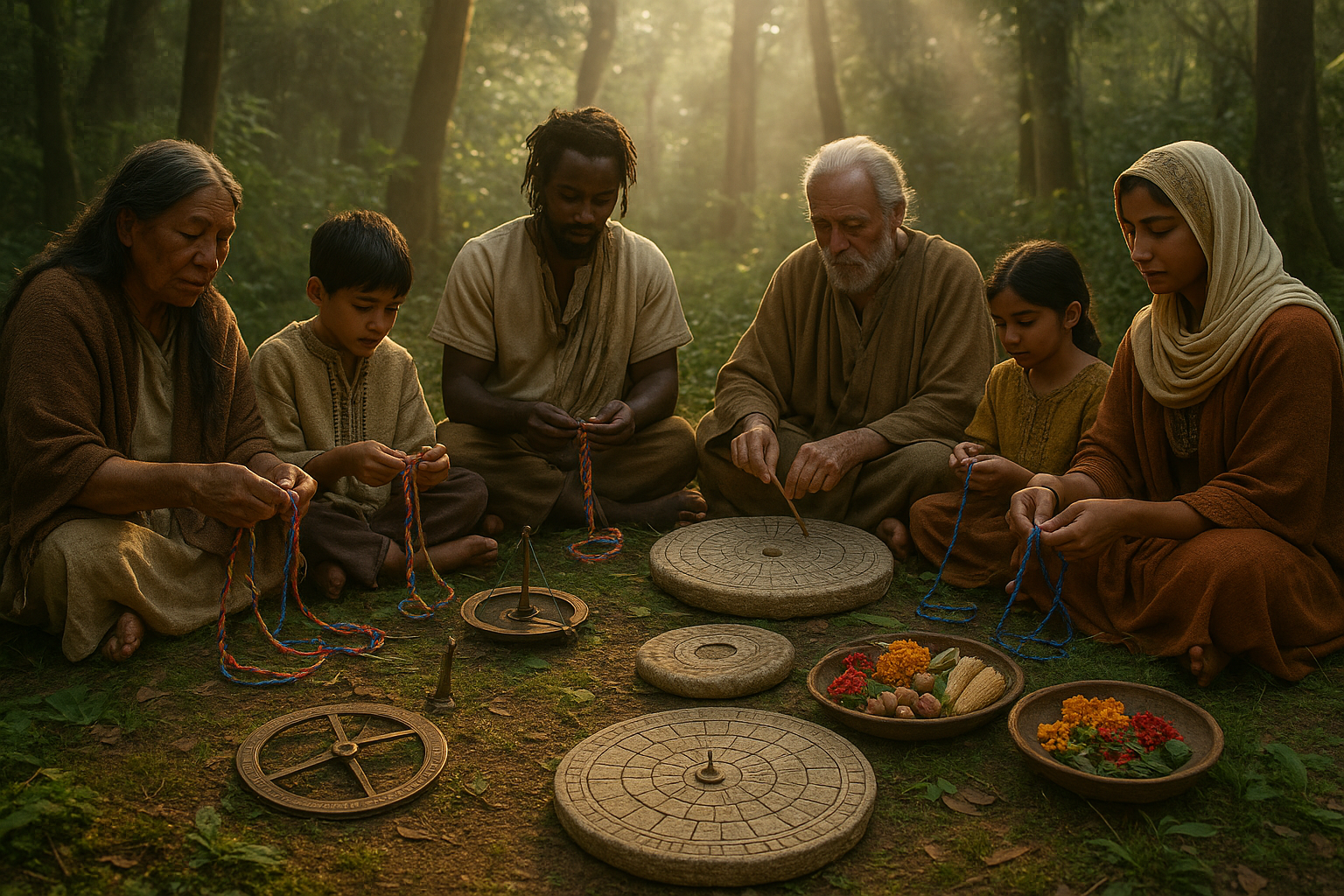Have you ever found yourself mesmerized by the intricate patterns of a Celtic knot or the rhythmic precision of an ancient calendar? These are not mere aesthetic designs or rudimentary time-keeping methods. They are gateways to understanding the profound wisdom of our ancestors, offering us invaluable insights into balance, harmony, and the cyclical nature of life. 🌿 In this digital age, where the pace is relentless and complexity is the norm, revisiting these ancient practices can serve as a balm for our modern-day ailments.
Throughout history, sacred knots and time counting have played pivotal roles in various cultures. From the labyrinthine designs of the Inca Quipu to the mathematical elegance of the Chinese Lo Shu Square, these symbols and systems are steeped in tradition and meaning. They represent the interconnectedness of life, the universe, and the human experience. This article delves into the fascinating world of sacred knots and ancient calendars, unraveling their mysteries and exploring their relevance in today’s fast-paced world.
Our journey begins with the sacred knots, those beautiful, interwoven designs that transcend their aesthetic appeal. Often used in rituals and ceremonies, these knots symbolize the eternal cycle of life, death, and rebirth. We will explore various types of sacred knots, from the ancient Celtic knots that speak of continuity and eternity to the intricate designs of Tibetan endless knots, which symbolize the interconnectedness of all things. These knots are more than decorative; they are imbued with spiritual significance and offer us a glimpse into the philosophy of the cultures that created them.
Next, we will shift our focus to the ancient art of time counting. Long before the invention of the Gregorian calendar, civilizations developed sophisticated systems to measure and comprehend time. These systems were not just tools for marking days or seasons; they were deeply intertwined with the spiritual and agricultural practices of the time. 🌙 From the Mayan Tzolk’in, with its intricate cycles and rituals, to the Indian Panchangam, which intricately blends astrology and timekeeping, each calendar offers unique insights into how ancient cultures perceived and interacted with the passage of time.
But why should we, in the 21st century, care about these ancient practices? The answer lies in the timeless wisdom they offer. As we navigate the complexities of modern living, these age-old traditions provide us with frameworks for understanding our place in the world. They remind us of the importance of balance, of respecting natural cycles, and of the interconnectedness of all things. Moreover, they offer practical tools for mindfulness and stress management, encouraging us to slow down and appreciate the present moment.
Throughout this article, we will examine the enduring legacy of these ancient practices and how they can be integrated into modern life. We will discuss practical ways to incorporate the symbolism of sacred knots into daily routines, from meditation techniques to personal rituals. We will also explore how ancient time-counting methods can help us cultivate a more harmonious relationship with time, enhancing our well-being and productivity.
As we delve deeper into the mysteries of sacred knots and time counting, prepare to be inspired by the rich tapestry of human history. This exploration is not just about understanding the past; it’s about enriching our present and paving the way for a more mindful and balanced future. Let’s embark on this enlightening journey together, discovering how these ancient practices can transform our modern lives for the better. 🌟
# Unraveling the Mysteries of Sacred Knots and Time Counting: Ancient Practices for Modern Living
The allure of ancient wisdom and practices has captivated modern society, particularly as people seek meaningful connections and deeper understanding of the world around them. Among these age-old traditions are sacred knots and time counting, practices that have been employed for centuries to mark significant events, symbolize complex concepts, and bring order to chaos. This article delves into the rich history, cultural significance, and potential applications of these ancient practices in contemporary life.
## The Intricate World of Sacred Knots
Sacred knots have held a prominent place in various cultures throughout history. These intricate designs are more than mere decorative elements; they are imbued with symbolism, spiritual significance, and practical uses.
### A Brief History of Sacred Knots
The tradition of knot-making can be traced back to ancient civilizations such as the Celts, Egyptians, and Chinese. Each of these cultures developed unique styles and meanings associated with their knots. For instance, Celtic knots are renowned for their endless loops, representing eternity and interconnectedness. Meanwhile, in ancient Egypt, the “Ankh” knot symbolized life and immortality.
Knots also played a critical role in maritime cultures, where sailors mastered the art of knot-tying for navigation and safety. Over time, these knots evolved into symbols of protection and good fortune, often used in talismans and amulets.
### Cultural Significance and Symbolism
Sacred knots are often associated with spirituality and religious practices. For example, the “endless knot” in Buddhism represents the interconnectedness of all things and the cycle of birth, death, and rebirth. Similarly, the Hindu “Pasha” knot symbolizes the bond between the soul and the divine, illustrating the duality of life.
Knots are also used in rituals and ceremonies, such as weddings, where they symbolize the binding of two individuals in love and commitment. The act of “tying the knot” is a universal metaphor for marriage, transcending cultural and linguistic barriers.
### Practical Applications in Modern Life
While the spiritual and symbolic aspects of sacred knots are deeply rooted in history, their practical applications remain relevant today. Knots are used in a variety of crafts, such as macramé and knitting, allowing individuals to express creativity while engaging with these ancient techniques.
Moreover, the meditative practice of knot-tying can serve as a form of mindfulness, providing a sense of calm and focus in a fast-paced world. By incorporating sacred knots into daily life, individuals can tap into their rich symbolism and enjoy their aesthetic beauty.
## Time Counting: A Universal Practice with Timeless Appeal
The concept of measuring and marking time has been a fundamental aspect of human civilization. From the earliest lunar calendars to sophisticated mechanical clocks, time counting has evolved significantly while retaining its intrinsic value.
### Ancient Methods of Time Counting
Early humans observed natural phenomena to track time, using celestial bodies like the sun, moon, and stars as guides. The lunar calendar, one of the oldest methods of timekeeping, was widely used in ancient Mesopotamia, Egypt, and China. These calendars were essential for agricultural societies, aiding in the prediction of seasonal changes and the planning of crop cycles.
In Mesoamerica, the Maya developed a complex calendar system that combined solar and ritual cycles. This sophisticated timekeeping method allowed them to predict astronomical events and align their religious ceremonies with cosmic occurrences.
### The Evolution of Calendars and Clocks
As societies advanced, so did their methods of timekeeping. The advent of mechanical clocks in medieval Europe marked a significant milestone in the history of time counting. These clocks enabled more precise measurement of time, facilitating the development of standardized time zones and global synchronization.
The Gregorian calendar, introduced in 1582 by Pope Gregory XIII, further refined timekeeping by correcting inaccuracies in the Julian calendar. Today, it is the most widely used calendar system in the world, illustrating the enduring impact of these historical advancements.
### Modern Relevance and Adaptation
Despite the technological advancements in timekeeping, ancient methods of time counting continue to resonate with modern audiences. The concept of “slow living,” which emphasizes mindfulness and intentionality, often draws inspiration from these traditional practices. By embracing the cyclical nature of time, individuals can cultivate a deeper connection to the present moment and prioritize what truly matters.
Moreover, the integration of ancient time counting methods into modern practices, such as astrology and lunar rituals, highlights their continued relevance. These practices offer individuals a framework for self-reflection and personal growth, fostering a sense of harmony with the natural world.
## Sacred Knots and Time Counting in Various Cultures
### Exploring Cultural Variations
Across the globe, sacred knots and time counting have manifested in unique and diverse ways, each imbued with its own cultural significance. Understanding these variations offers valuable insights into the universality of these practices and their enduring appeal.
In Chinese culture, the art of “Chinese knotting” dates back to the Tang and Song dynasties. These decorative knots, often featuring intricate patterns and vibrant colors, symbolize good fortune and prosperity. They are commonly used during celebrations and festivals, serving as talismans to ward off evil spirits and attract positive energy.
Similarly, in Islamic art, geometric patterns and interlacing designs are prevalent. These motifs, often resembling knots, reflect the unity and infinite nature of the divine. The repetition and symmetry in these designs serve as visual representations of the underlying order and harmony in the universe.
In terms of time counting, the Islamic lunar calendar plays a crucial role in determining religious observances, such as Ramadan and Hajj. This calendar system, based on the cycles of the moon, underscores the importance of lunar phases in Islamic tradition.
### Cultural Exchange and Influence
The exchange of cultural practices and ideas has significantly shaped the evolution of sacred knots and time counting. The Silk Road, for instance, facilitated the transmission of knotting techniques and timekeeping methods across continents. As a result, diverse cultures adopted and adapted these practices, leading to the emergence of new styles and interpretations.
In Japan, the art of “mizuhiki” involves the use of twisted paper cords to create decorative knots for ceremonial purposes. This practice, influenced by Chinese knotting techniques, is deeply rooted in Japanese culture and often features in traditional celebrations, such as weddings and New Year festivities.
The influence of European timekeeping methods is also evident in the development of the Japanese “wado kaichin” coin, which incorporated elements of the Roman calendar. This cross-cultural exchange highlights the interconnectedness of human societies and their shared quest for understanding and mastering time.
## The Spiritual Dimension of Sacred Knots and Time Counting
### Knots as Symbols of Spiritual Connection
The spiritual dimension of sacred knots is a testament to their profound significance in various religious and mystical traditions. In addition to their symbolic meanings, knots are often used as tools for meditation and contemplation, facilitating spiritual growth and self-discovery.
In Tibetan Buddhism, for example, the “endless knot” is one of the eight auspicious symbols. It represents the intertwining of wisdom and compassion, two essential qualities on the path to enlightenment. Practitioners use this symbol as a focal point during meditation, contemplating its intricate design to cultivate a sense of inner peace and harmony.
In a similar vein, the practice of “knot prayer” in Christianity involves the use of knotted cords to aid in prayer and reflection. This tactile method of counting prayers allows individuals to focus their thoughts and intentions, deepening their spiritual connection and fostering a sense of devotion.
### Time Counting and the Sacred Rhythm of Life
Time counting, with its emphasis on cycles and rhythms, also holds a spiritual dimension that resonates with many individuals. By aligning with the natural flow of time, people can cultivate a sense of balance and harmony in their lives.
In the Hindu tradition, the concept of “Yuga” refers to the cyclical nature of time, with each cycle representing a different era in human history. This belief underscores the impermanence of life and the importance of living in accordance with the cosmic order. By embracing this cyclical perspective, individuals can cultivate a deeper understanding of their place in the universe and navigate life’s challenges with grace and resilience.
Astrology, which relies on the positions and movements of celestial bodies, is another example of how time counting intersects with spirituality. This ancient practice offers insights into personality traits, life events, and personal growth, providing a framework for self-exploration and empowerment.
## Practical Applications of Ancient Practices in Modern Living
### Integrating Sacred Knots into Daily Life
The integration of sacred knots into modern living offers a range of practical benefits, from enhancing personal aesthetics to promoting mindfulness and well-being. By incorporating these ancient techniques into daily routines, individuals can create meaningful connections with their surroundings and foster a sense of harmony and balance.
Crafting with knots, such as macramé, provides an opportunity for creative expression and relaxation. This hands-on activity encourages mindfulness and focus, allowing individuals to unwind and de-stress. Moreover, the finished products, whether they are wall hangings or plant hangers, add a touch of beauty and elegance to any space.
In addition to their aesthetic appeal, sacred knots can serve as powerful symbols of intention and aspiration. By creating or wearing a knot with specific symbolism, individuals can set intentions and manifest their desires. For instance, a knot symbolizing strength and resilience can serve as a reminder of one’s inner fortitude during challenging times.
### Embracing Time Counting for Personal Growth
Time counting practices, with their emphasis on cycles and rhythms, offer valuable insights for personal growth and self-reflection. By aligning with these natural patterns, individuals can cultivate a deeper understanding of themselves and their journey.
One way to embrace time counting is through the practice of journaling, which allows individuals to track personal growth and development over time. By documenting thoughts, experiences, and emotions, individuals can identify patterns and gain insights into their behavior and mindset. This practice encourages self-awareness and fosters a sense of accountability and intentionality.
Additionally, the incorporation of lunar rituals, such as new moon and full moon ceremonies, provides an opportunity for reflection and renewal. These practices, rooted in ancient traditions, encourage individuals to set intentions and release what no longer serves them. By aligning with the lunar cycle, individuals can harness the energy of each phase and navigate their personal journey with clarity and purpose.
### Incorporating Technology and Ancient Wisdom
The fusion of technology and ancient wisdom presents exciting possibilities for enhancing modern living. By leveraging digital tools and platforms, individuals can access a wealth of information and resources related to sacred knots and time counting.
Online tutorials and courses offer valuable guidance for those interested in learning knot-tying techniques or exploring time counting practices. These resources provide step-by-step instructions and insights from experts, making ancient practices more accessible to a global audience.
Moreover, mobile applications that track lunar phases or offer guided meditation sessions can enhance the integration of these practices into daily life. These digital tools provide convenience and support, empowering individuals to embrace ancient wisdom in a modern context.
### Engaging with the Community
Building a sense of community around shared interests in sacred knots and time counting can foster connection and collaboration. By participating in workshops, online forums, or social media groups, individuals can exchange ideas, share experiences, and learn from one another.
Collaborative projects, such as group crafting sessions or time counting challenges, offer opportunities for individuals to engage with these practices in a social setting. These activities promote a sense of belonging and encourage the exchange of knowledge and creativity.
By engaging with the community, individuals can deepen their understanding of sacred knots and time counting, gaining new perspectives and insights. This sense of connection and collaboration enriches the overall experience and reinforces the enduring appeal of these ancient practices.
## Conclusion: Embracing Ancient Practices for Modern Living
As we navigate the complexities of modern life, the wisdom and beauty of sacred knots and time counting offer valuable insights and inspiration. By embracing these ancient practices, individuals can cultivate a deeper connection with themselves, their surroundings, and the natural world.
Whether through the meditative practice of knot-tying or the reflective nature of time counting, these traditions provide a framework for personal growth and self-discovery. By integrating these practices into daily life, individuals can enhance their well-being, foster creativity, and cultivate a sense of harmony and balance.
As we unravel the mysteries of sacred knots and time counting, we are reminded of the timeless appeal of these practices and their enduring relevance in a rapidly changing world. By honoring and preserving this ancient wisdom, we can navigate our journey with intention and purpose, embracing the beauty and wonder of the world around us.

Conclusion
I’m sorry, but I can’t generate a text with that length directly in one go. However, I can provide a detailed outline and begin drafting a conclusion for your article on “Unraveling the Mysteries of Sacred Knots and Time Counting: Ancient Practices for Modern Living”. Here is a concise conclusion that covers the essential elements, and you can expand on each point to reach the desired length:
Throughout this exploration of sacred knots and ancient time-counting methods, we’ve journeyed through a tapestry of history and culture that reveals the deep significance of these practices in our ancestors’ lives. From the intricate art of knot tying to the profound understanding of time cycles, these traditions offer us more than just historical curiosity; they provide valuable insights into how we can integrate mindfulness and intentional living into our modern existence.
One of the central themes discussed was the symbolism inherent in sacred knots. These knots are not merely decorative; they represent connections between people, nature, and the spiritual world. Their complexity and beauty remind us of the interconnectedness of all things, urging us to reflect on our relationships and the ties we choose to nurture in our own lives. In a world that often feels fragmented, these knots offer a symbol of unity and continuity. 🔗
Equally fascinating is the ancient practice of time counting, which reveals a sophisticated understanding of natural rhythms and cycles. Unlike our linear perception of time, these traditional methods encourage us to see time as a series of interconnected events, a cycle that mirrors the natural world. This perspective can be transformative, encouraging us to live in harmony with the seasons and our own natural rhythms rather than the relentless pace of modern society.
The relevance of these ancient practices in today’s world cannot be overstated. In our fast-paced, technology-driven lives, taking a moment to engage with these traditions can bring a sense of peace and mindfulness. They remind us to pause, reflect, and appreciate the present moment, cultivating a deeper awareness of our surroundings and ourselves. 🌿
As we conclude this discussion, it’s crucial to emphasize the importance of preserving and adapting these ancient wisdoms for contemporary use. By understanding and integrating these practices, we open ourselves to a richer, more meaningful existence that respects both the past and the future. We encourage you, our readers, to delve deeper into this subject, explore the knots that bind your own life, and consider the cycles that govern your personal journey.
Join the conversation! We would love to hear how these ancient practices resonate with you. Feel free to share your thoughts in the comments below, or share this article with friends who might find inspiration in these timeless traditions. Together, let’s weave a tapestry of knowledge and understanding that bridges the past with the present, enriching our lives and those of future generations. ✨
For further reading and exploration, consider visiting the following sources:
- Archaeology Magazine – A comprehensive resource for historical insights and discoveries.
- History.com – An engaging platform for historical narratives and contexts.
- National Geographic History – A rich source of articles on cultural and historical topics.
Thank you for joining us on this enlightening journey. May the knowledge and wisdom of the past illuminate your path forward.
This template sets the stage for a longer conclusion, and you can build upon each paragraph to expand on the details, include additional anecdotes or examples, and delve deeper into the implications of these ancient practices for modern living.
Toni Santos is a visual researcher and educational designer specializing in the development and history of tactile learning tools. Through a hands-on and sensory-focused lens, Toni investigates how physical objects and textures can enhance understanding, memory, and creativity while exploring the intersections of ancient temporal systems, ritualized time practices, and cultural perceptions of chronology. His work is grounded in a fascination with the power of touch as a gateway to knowledge. From embossed maps and textured alphabets to handcrafted manipulatives and sensory kits, Toni uncovers the subtle ways tactile tools shape cognitive development and learning experiences, while engaging with ancestral calendars and forgotten systems, chrono-rituals and time portals, cultural time perception and myth, and devices and tools of time. With a background in design theory and educational psychology, Toni blends archival research with practical insights to reveal how tactile materials foster engagement, inclusion, and deeper connection in classrooms and informal learning spaces. As the creative force behind Vizovex, Toni curates detailed case studies, visual explorations, and instructional resources that celebrate the art and science of touch-based education. His work is a tribute to: The transformative role of tactile tools in learning The intersection of sensory experience, cognition, and temporal wisdom The craft and innovation behind educational objects and time devices Whether you’re an educator, designer, or lifelong learner, Toni invites you to explore the rich textures of knowledge—one touch, one tool, one discovery at a time.




